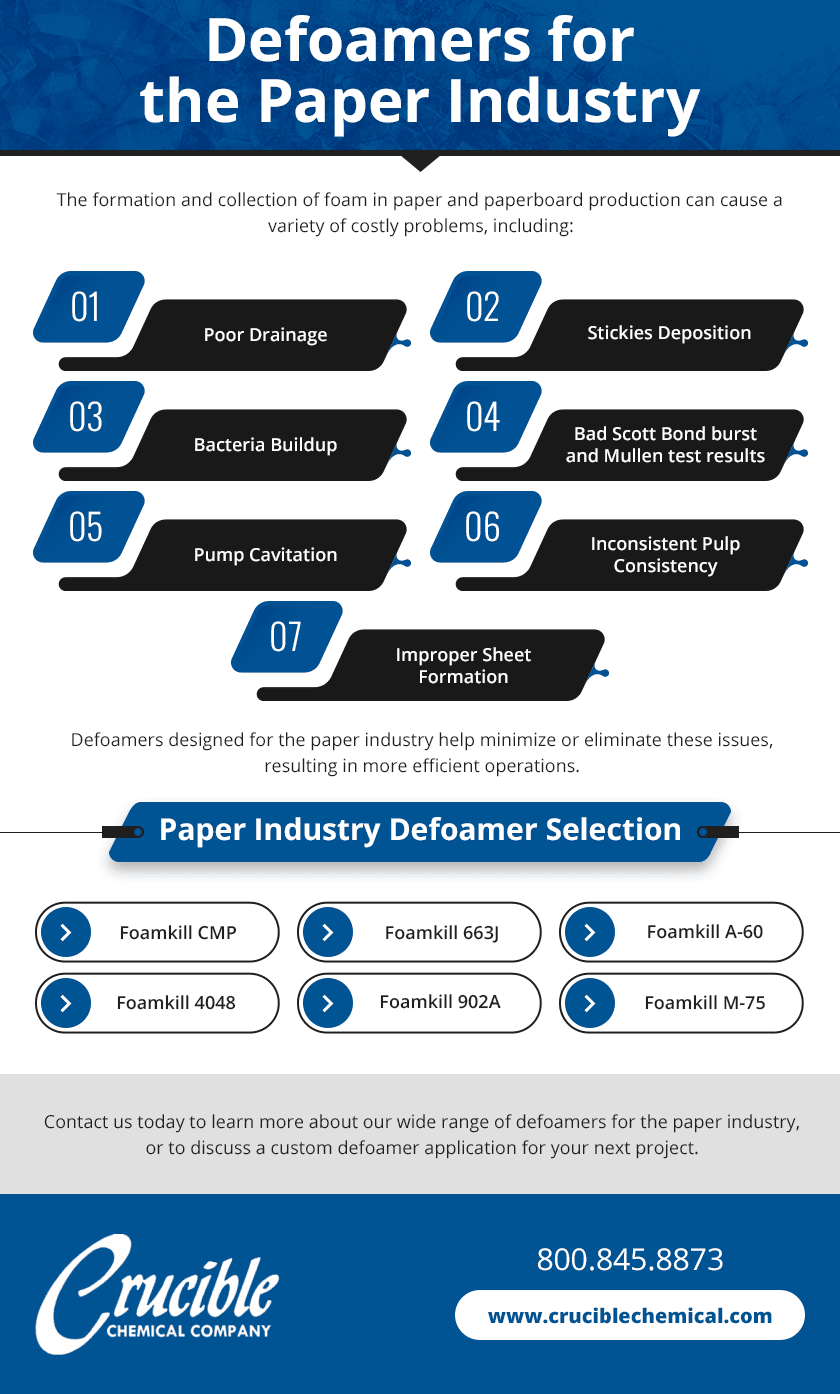Exactly How Defoamers Improve Effectiveness in Production and Manufacturing

Understanding Defoamers
Defoamers play a critical role in different making procedures by effectively combating the formation of foam, which can interfere with procedures and affect item quality. Foam can occur in many contexts, such as throughout blending, home heating, or chain reactions, potentially resulting in ineffectiveness and incongruities in items. The mechanism by which defoamers operate usually includes minimizing the surface area stress of the liquid, permitting bubbles to rise and coalesce to the surface much more readily, where they can then break.
Reliable defoamers not only decrease foam formation yet likewise keep compatibility with the product, ensuring that there are no negative effects on the last output. Recognizing the homes and functions of defoamers is necessary for producers intending to optimize their procedures, enhance efficiency, and maintain the stability of their products (defoamers).
Secret Advantages of Defoamers
Using defoamers in making processes uses a variety of substantial benefits that improve functional efficiency and item high quality. Among the main benefits is the reduction of foam formation throughout manufacturing, which can obstruct equipment and interrupt operations. By reducing foam, defoamers make certain smoother operations, leading to lowered downtime and maintenance prices.
In addition, defoamers enhance product uniformity by stopping air entrapment, which can jeopardize the integrity of the end product. This is specifically important in markets where visual appearance and structure are crucial, such as in paints, layers, and foodstuff. Enhanced product high quality not only satisfies client assumptions yet also strengthens brand track record.
Additionally, defoamers can assist in maximizing source use. By improving the efficiency of basic material usage, they add to set you back savings and minimized waste, lining up with sustainability objectives. The application of defoamers can lead to much shorter handling times, making it possible for suppliers to raise manufacturing ability without substantial resources financial investment.
Applications in Numerous Industries
In producing processes across different markets, the application of defoamers plays a vital duty in boosting effectiveness and product high quality. These chemical additives are employed in fields such as food and drink, drugs, and textiles to mitigate foam-related obstacles.
In the food and drink market, defoamers are important during the fermentation procedure, avoiding foaming that can interfere with manufacturing and ruin the product's integrity. In the pharmaceutical market, defoamers are used in the solution of liquid medications, making sure uniformity and security while reducing waste.
Fabric manufacturing additionally benefits from defoamers, as they are used in coloring and finishing processes to advertise even circulation of dyes and chemicals. This application not only enhances the final product's look however additionally reduces the quantity of water and energy taken in during production.
Furthermore, in the paper and pulp market, defoamers help keep process effectiveness by minimizing foam that can impede equipment performance. Overall, the diverse applications of defoamers throughout these markets highlight their Continue importance in maximizing manufacturing procedures and delivering premium products.

Choosing the Right Defoamer
Choosing a proper defoamer is vital for optimizing performance and top quality in manufacturing processes. The selection of defoamer depends on numerous factors, consisting of the particular application, the sort of foam being generated, and the formulation of the product being manufactured.

Firstly, take into consideration the chemical compatibility of the defoamer with other ingredients in your formula. A defoamer that communicates adversely with various other elements can detrimentally impact item high quality. Additionally, the temperature level and pH range during handling are crucial; some defoamers carry out optimally under particular conditions while becoming inadequate in others.
Secondly, assess the defoamer's performance attributes, such as its ability to promptly minimize foam and its persistence throughout manufacturing. It is vital to choose an item that not just removes foam swiftly yet additionally preserves its effectiveness over time.
Finally, consider environmental and regulative factors, specifically if your manufacturing procedure is subject to strict conformity criteria. Choosing a biodegradable or low-toxicity defoamer can assist meet sustainability objectives check my site while ensuring operational effectiveness. By attentively assessing these standards, producers can make enlightened choices that enhance productivity and product integrity.
Best Practices for Execution
Effective implementation of defoamers in producing procedures requires cautious planning and adherence to ideal techniques. It's vital to conduct an extensive analysis of the manufacturing setting. This consists of understanding the specific application, the sorts of foaming representatives present, and the operational conditions. Selecting the best defoamer, as previously reviewed, is critical; ensure it works with the materials involved and resolves the recognized foaming concerns effectively.
Next, preserve clear communication with all stakeholders, including drivers and quality assurance groups. Training sessions can assist make certain that every person recognizes the application treatments, prospective impacts on product top quality, and safety and security factors to consider. Implementing a trial phase can additionally be helpful; display efficiency closely to determine performance and make required changes.
Furthermore, regular testing and tracking of foam degrees can supply important understandings into the defoamer's performance over time. Adjusting dosages in reaction to modifications in manufacturing variables will certainly help keep optimal efficiency - defoamers. Documenting all processes and results promotes constant enhancement, permitting for this fine-tuning of defoamer usage and enhancing total performance in producing procedures.
Conclusion
In recap, defoamers play a critical role in boosting efficiency within manufacturing and manufacturing procedures. By decreasing foam development and assisting in bubble coalescence, defoamers contribute to improved product high quality, consistency, and functional effectiveness.
The advantages prolong to product high quality and expense savings, as defoamers help simplify procedures.Defoamers play a vital role in various producing processes by successfully combating the formation of foam, which can interfere with procedures and impact item top quality. Recognizing the buildings and functions of defoamers is crucial for manufacturers aiming to enhance their processes, boost efficiency, and maintain the integrity of their items.
Utilizing defoamers in producing procedures provides a range of considerable benefits that boost operational performance and product top quality.Furthermore, defoamers enhance item consistency by avoiding air entrapment, which can endanger the integrity of the last product.